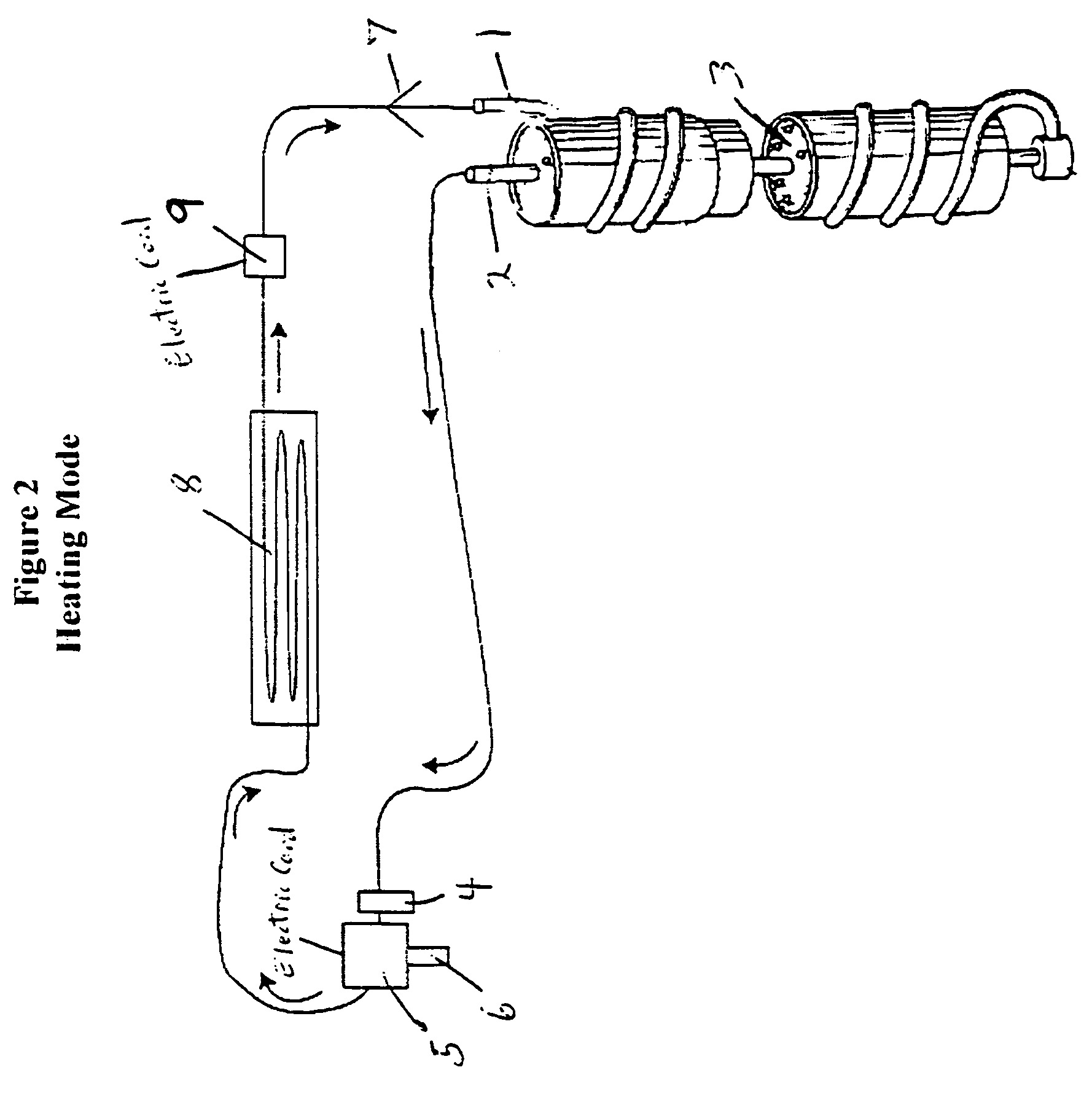[0008]The liquid refrigerant fluid pump will be sized to offset the head pressure of the
liquid state refrigerant in the
liquid line, depending on the volume, weight, depth or height, of fluid in the
liquid line, as well as taking other factors into account, such as the system operating pressures, the refrigerant transport tubing's interior wall resistance, the overall refrigerant
fluid volume, and the like, which factors and calculations are readily understood by those in the field. This will enable the compressor to operate at its maximum design efficiency as a compressor, and will further enable direct-expansion, refrigerant-based,
geothermal heating and cooling systems, whether operating in a single heating or cooling mode or in a reverse-cycle mode, to efficiently operate with the in-ground heat exchange lines installed at any depth, or at any elevation, or at any distance, desired. Liquid pumps operate very efficiently with minimal power requirements.
Refrigerant compressors operate very efficiently as compressors when they are not required to additionally provide pumping power, for which pumping purposes they were not primarily designed. Consequently, the invention enables maximum efficiencies to be achieved when significant elevation differentials are desirable between the compressor and the condenser, such as when the in-ground heat exchange tubing is installed in a deep well direct expansion geothermal system operating in a cooling mode.
[0010]Another
advantage of utilizing a fluid pump in a direct expansion system would be to solve the common low-pressure start-up problem when the system is operating in the cooling mode. Since refrigerant fluid naturally migrates to the coolest point in the system, at the beginning of the cooling season, when the ground is operating as the condenser in a direct expansion
geothermal heat pump system, the ground surrounding the condensing lines has supplied heat throughout the winter and is usually the coldest point. As a result, when the system has satisfied the interior
air temperature requirements and shuts off, a significant portion of the refrigerant fluid migrates to the cold ground condensing lines and remains there in a
liquid state. Consequently, the refrigerant in a vapor state is depleted, often causing the compressor to automatically
shut down via its own internal low-pressure safety
cut-
off design. To overcome this problem, various geothermal direct expansion system designs, such as William E. Dressler U.S. Pat. No. 5,461,876 incorporate a re-
programming of the compressor to continue to operate, or to continue to periodically repeat the start-up mode until enough refrigerant is moved into the
evaporator to commence normal system operation. This re-
programming of the compressor reduces the compressor life and consumes large amounts of energy, thereby reducing overall system efficiencies. By
programming the fluid pump to start prior to the compressor, as is readily understood by those skilled in the trade, so as to equalize or to approximately equalize refrigerant pressures on both sides of the compressor unit, the necessity to re-program the compressor to continuously repeat start-up attempts under low pressure conditions is eliminated.
[0015]Absent a readily available submersible liquid refrigerant pump, an available Side Channel Pump, with an optional by-pass valve to prevent any
vapor lock potential and to initiate self-priming, or the like, can be utilized for effective system operation. Although not typically reversible, Side Channel Pumps, such as those manufactured by Corkin, Inc., can be placed at an accessible above-ground location in the
liquid line between the two expansion valves. Reverse direction refrigerant fluid flow through a Side Channel Pump is easily accomplished by means of one directional
piping and valve by-passes, just as utilized for the compressor, as is well known and understood by those in the trade. Again, rather than require a variable speed Side Channel Pump for reversible system operation or other changing conditions, more than one such pump, of respective varying powers, can be placed in respective divided segments of the liquid refrigerant line, with one or more such pumps programmed to operate depending upon
system requirements.
[0016]An alternative to utilizing a Side Channel Pump, or the like, would be to utilize a readily available, but oversized,
scroll compressor, or the like, in its place, such as those scroll compressors manufactured by Scroll Technologies, of One Scroll Drive, Arkadelphia, Ark. 71923. Scroll compressors, well known to those skilled in the field, can effectively pump either refrigerant liquid or vapor. By over-
sizing a standard
scroll compressor so that the intake is expanded in size, but so that the
discharge capacity and rate, after having calculated and added appropriate capacity for fluid head pressure and
line resistance factors and the like, is equal or approximately equivalent to the intake design rate of the system's primary compressor unit, with the system's primary compressor unit's
intake rate calculated absent any system liquid head or
line resistance issues, and the like, taken into account, there will be either no or minimal compression work load expended by the scroll pumping unit, and the over-sized
scroll compressor will, as a result, efficiently utilize its energy solely in a pumping capacity.
[0017]In another alternative, the scroll compressor, designed to compress a refrigerant vapor, can be easily modified by the factory to a non-compression scroll design, as would be readily understood by those in the trade, so as to avoid the necessity to oversize the scroll unit when solely utilized in a pumping capacity. The same applications and the same factory modification, as described for a scroll compressor unit, can be applied to a screw compressor unit, such as those manufactured by York International, of 631 South Richland Avenue, York, Pa. 17403, or to any other appropriately designed compressor unit capable of pumping both vapor and
liquid state refrigerant.
 Login to View More
Login to View More  Login to View More
Login to View More 


